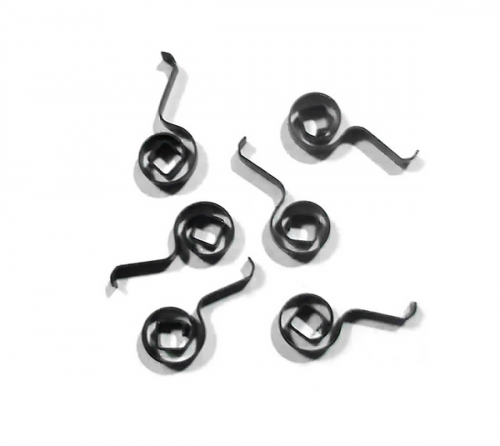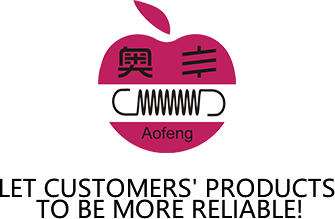Common parts of mechanical design: summary of basic knowledge of springs
Date of release:2019-09-25 00:00:00 Author: Click:
Spring is a kind of elastic element widely used in the mechanical and electronic industry. When the spring is under load, it can produce great elastic deformation and convert mechanical work or kinetic energy into deformation energy. After unloading, the deformation of the spring disappears and returns to the original state, and the deformation energy is converted into mechanical work or kinetic energy. The ratio of load and deformation of the spring is called spring stiffness, the greater the stiffness, the harder the spring.

1, the role of springs
Buffering and damping. Such as car, train under the vibration of the spring, a variety of buffer buffer spring.
Control the movement of the mechanism. Such as the valve spring in the internal combustion engine, the control spring in the clutch, etc.
Storing and exporting energy. Such as clock springs, latch springs, etc.
Measure the magnitude of the force. Such as spring balance, force meter in the spring, etc.
2. Classification of springs
According to the nature of force spring is divided into: stretch spring, compression spring, torsion spring and bending spring.
Tensile spring (referred to as tension spring) is to bear the axial tension of the helical spring, tensile spring is generally made of circular section material. When the load is not borne, the tension between the spring ring and ring are generally tight and no gap.
Compression spring (compression spring for short) is a helical spring under pressure, its material section is mostly round, but also useful rectangular and multi-strand steel entwined rolling, spring is generally equal to the pitch, compression spring ring and ring have a certain gap, when subjected to external load when the spring contraction deformation, deformation energy storage.
A torsion spring is a helical spring. A torsional spring can store and release angular energy or hold a device in place by rotating the moment arm around the axis of the spring body. The ends of the torsional spring are fixed to other components, and as the other components rotate around the center of the spring, the spring pulls them back to their original position, producing a torque or rotational force.
There are also two unusual types of air springs and carbon nanotube springs.
Air spring is adding pressure air in flexible airtight container, using air compressibility realize a kind of non-metallic elastic effect of spring, in the high-end vehicle suspension device can greatly improve the vehicle ride comfort, thus greatly improve the comfort of the vehicle operation, so the air spring in automobile, railway locomotive has been widely used.
Carbon nanotube springs: carbon nanotube films need to be made first, and then the spinning technology is used to spin the carbon nanotube films into carbon nanotube springs. With a diameter of hundreds of microns and a length of several centimeters, it is expected to be used in stretchy conductors, flexible electrodes, miniature strain sensors, supercapacitors, integrated circuits, solar cells, field emission sources, energy-dissipating fibers and other fields. It is also expected to be used in medical devices, such as tension sensing bandages.
3, spring material and allowable stress
Spring in the work is often subjected to alternating and impact load, and requires a larger deformation, so the spring material should have a high tensile strength, elastic limit and fatigue strength. In the process to have a certain degree of hardenability, not easy to decarbonization, good surface quality.
4. Manufacture of springs
The manufacturing process of spiral spring includes: rolling, hook making or end ring finishing, heat treatment and process performance test.
When mass production, is in the universal automatic spring rolling machine; Single pieces and small batches are made on a lathe or by hand. When the diameter of spring wire is less than or equal to 8mm, cold rolling method is commonly used. Heat treatment is required before rolling and low temperature tempering is required after rolling. When the diameter is larger than 8mm, hot coil (hot coil temperature: 800 ° c ~ 1000 ° c) method is adopted. After the hot coil is quenched and tempered at medium temperature, the surface quality shall be inspected after the spring forming, and the surface shall be smooth and clean, without scars or decarbonization defects. The spring subjected to variable load must also be shot peening and other surface treatment, in order to improve the fatigue life of the spring.
5. End structure of spring
Compression spring in addition to participate in the deformation of the effective number of cycles n, in order to make the compression spring work force uniform, to ensure that the spring center line perpendicular to the end face, the spring at both ends of each 3/4 ~ 7/4 ring and tight supporting role, when the work does not participate in the deformation, so it is called dead ring or supporting ring.
The end of the extension spring has a hook for installation and loading. There are four types of common end structures. Semicircular hook ring and circular hook ring are easy to manufacture and widely used. However, due to the great bending stress in the hook transition, they are only suitable for spring whose diameter of spring wire is d≤10mm. Adjustable and rotatable hooks are under good stress and can be turned to any position for easy installation.
6, spring is not in place and failure reasons
In the actual work, we often encounter the spring can not push the moving object to the set position, that is to say, the calculating free length of the spring has become shorter. The main reason for this is that there is no initial compression, that is, the operation of taking a spring made into a spring and applying a greater force to compress it to its compression height or to its compression height (if necessary), and not being able to return to its original free length when released. The reduction is called "initial compression". Generally repeated 3-6 times after the compression, the length is no longer shortened, that is, the spring "positioning". After initial compression, the spring deforms for a long time.
7. Spring precautions
In practice, a spring can maintain its working length even if it is subjected to a force beyond the elastic limit of the material. Therefore, the length of the finished spring should be equal to the calculated length of the spring plus the initial compression, which can avoid the spring not in place, so as to avoid dangerous stress when the spring ring is tight, resulting in abnormal spring line and not in place. Finished spring in the process of heat treatment, especially after quenching and tempering process, the workpiece must be horizontal (horizontal) in the furnace, in case the spring due to the role of weight and short lead to work not in place.
The address of this article:http://en.afthcn.com/news/528.html
Key word:拉伸弹簧厂家,扭转弹簧厂家,异形弹簧厂家
Recently browse:
Related products:
Related news:
- What are the types of springs?
- The role of hot coil spring is not to be underestimated
- Frequently asked questions about stretch springs
- Look at the compact function of hardware springs
- Processing characteristics of spring zinc plating
- What are the properties of a plane coil spring?
- What are the factors that affect the selection of spring material?
- How to choose medical instrument spring
- How to pressure test precision spring?
- Heat treatment process of shaped spring












